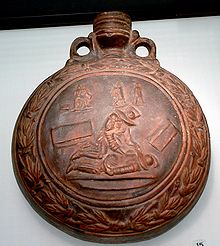This article needs additional citations for verification. (December 2022) |

The murmillo (also sometimes spelled "mirmillo", "myrmillo", or "mirmillones" pl. murmillones) was a type of gladiator during the Roman Imperial age. The murmillo-class gladiator developed in the early Imperial period to replace the earlier Gallus-type gladiator, named after the warriors of Gaul (Latin: Gallus, lit. 'a Gaul'). As the Gauls inhabiting Italy had become well integrated with the Romans by the time of the reign (27 BCE to 14 CE) of Augustus, it became undesirable to portray them as enemy outsiders;[dubious – discuss] the Gallus-class gladiator thus fell out of use.[1]
The designation murmillo originated with the Greek word μορμύρος (mormyrus) for a type of fish[2] - murmillo gladiators could wear a Gallic-model helmet incorporating fish-imagery.[3][4]

- ^
Wiedemann, Thomas (11 March 2002) [1992]. "Gladiators and Roman Identity". Emperors and Gladiators. London: Routledge. p. 41. ISBN 9781134990405. Retrieved 13 October 2024.
During the first century BC [...] Samnites and at any rate those Gauls inhabiting Italy [...] were part of the process of Italian integration. By the time of Augustus, it had become inappropriate for them to be perceived as outsiders; and the Samnis turns into a secutor, while the Gallus becomes a murmillo.
- ^ "mirmillo". Oxford English Dictionary (Online ed.). Oxford University Press. (Subscription or participating institution membership required.) - "presumably so called in Latin because of the image of a fish on the gladiator's helmet."
- ^
Travis, Hilary; Travis, John (15 December 2014). "Gladiator Helmets". Roman Helmets. Stroud, Gloucestershire: Amberley Publishing Limited. ISBN 9781445638478. Retrieved 13 October 2024.
Whereas the Thracian helmet was provided with a crest, that of the Murmillo had a very large three-dimensional dorsal fin, presumably to represent a fish [...]. [...] Another example [...] is more elaborate, [...] decorated with an all-over silver-and-gold two-toned pattern to give the appearance from a distance of shimmering fish scales [...].
- ^
Harvey, Brian K. (3 June 2015) [2004]. "The Games: The Amphitheater: 121. Lycus, Murmillo". Roman Lives: Ancient Roman Life as Illustrated by Latin Inscriptions. Focus Classical Sources (corrected ed.). Indianapolis, Indiana: Hackett Publishing. p. 151. ISBN 9781585109753. Retrieved 13 October 2024.
The murmillo acquired his name from the type of helmet he wore: a Gallic helmet with a fish-shaped crest.